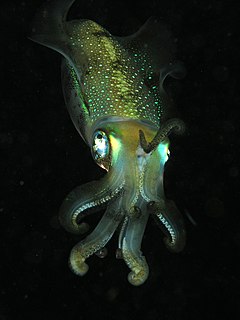| Paradeshayesites Temporal range: Aptian | |
|---|---|
| Scientific classification | |
| Kingdom: | Animalia |
| Phylum: | Mollusca |
| Class: | Cephalopoda |
| Order: | Ammonitida |
| Suborder: | Ancyloceratina |
| Family: | Deshayesitidae |
| Genus: | Paradeshayesites Kemper, 1967 |
Paradeshayesites is an extinct genus of cephalopod belonging to the Ammonite [1] subclass.

A cephalopod is any member of the molluscan class Cephalopoda such as a squid, octopus or nautilus. These exclusively marine animals are characterized by bilateral body symmetry, a prominent head, and a set of arms or tentacles modified from the primitive molluscan foot. Fishermen sometimes call them inkfish, referring to their common ability to squirt ink. The study of cephalopods is a branch of malacology known as teuthology.